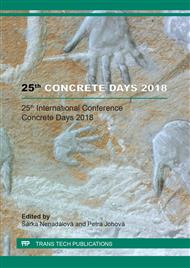p.69
p.79
p.85
p.91
p.96
p.102
p.108
p.114
p.123
Hydraulic Road Binder with High Share of Fly Ash after Denitrification
Abstract:
Power plants use new technologies to reduce emissions limits. Denitrification is a process that leads to the reduction of NOx in the flue gas. However, in this process, the ammonia or urea is bound to the fly ash and it may adversely affect the properties of this secondary material and it influences its practical utilisation. In this contribution research of siliceous fly ash after denitrification by SNCR in the field of hydraulic road binders for soil treatment is described. In the last time a number of new hydraulic road binders with fly ash as their component have been prepared and used. Fly ash is used due to its pozzolan properties (siliceous FA) or hydraulic properties (calcareous FA) and low purchase price. In described case, fly ash after denitrification was used in mixture with Portland cement and cement kiln dust in ratio 60/30/10. The prepared mixture showed good properties and fulfilled requirements of the EN 13282-2: Normal hardening hydraulic road binders. These binders have to comply with the requirements determined by cement standards.
Info:
Periodical:
Pages:
96-101
Citation:
Online since:
June 2019
Authors:
Keywords:
Price:
Сopyright:
© 2019 Trans Tech Publications Ltd. All Rights Reserved
Share:
Citation:


